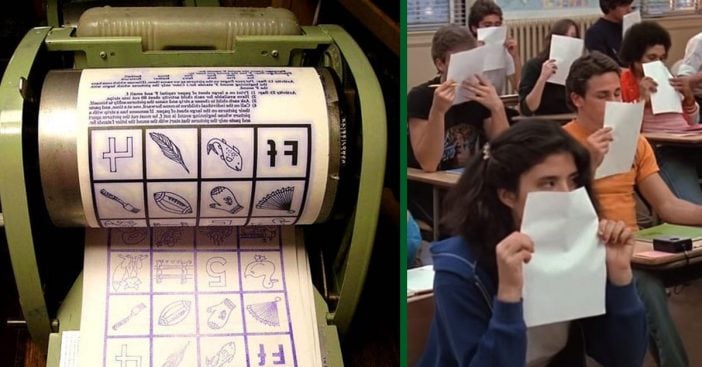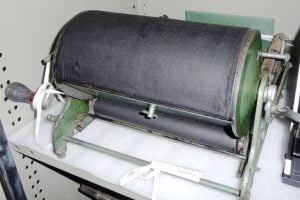
*FAQs at bottom of the article*
UPDATED 2/24/2023
Some typical daily tasks become passionless routines. But others ended up becoming a treat to fulfill. One particularly strong – and fragrant – example was working with the mimeograph. Classroom attendance became downright fun and interested as soon as this contraption got involved.Not only did it create a unique, pretty purple ink, but the mimeograph smell was unforgettable. Did you get to work with the mimeograph?
Science says memories of the mimeograph smell should come back especially easily. That’s because events with strong scents associated with them stick with us particularly well. Odors travel to the brain to get processed in the same area as memories and emotions. Fortunately, the mimeograph usually has pleasant feelings of excitement associated with it.
Printing success

The mimeograph had roots that reached far back and drew from different pieces of technology. National Geographic points to the days of the printing press. By 1876, Thomas Edison gave rise to the “electric pen and duplicating press.” When the patent went to A.B. Dick, the latter officially made it into the “mimeograph.” Think of it as the tool for what the photocopier does today. At its core, this device is a duplicating machine that allowed people to easily produce printed sheets en masse. This was helpful primarily in classrooms with activity sheets and even exams, but its usefulness made it popular for a variety of tasks. A lot of people’s earliest experiences, though, came from their classroom. But instead of evoking thoughts of boredom and desires for summer vacation, this got students’ attention.
RELATED: 12 Smells That Will Instantly Remind You Of Your Childhood In The 1960s
The mimeograph became the most widely used system for mass-producing papers with print on them. The ink it used ended up looking deep blue or purple. The materials also made mimeographed paper have a unique mimeograph smell. That fragrance came from the machine’s output; the duplicator fluid had methanol and isopropanol in it. It used a pen-type device that made stencils through one sheet that the ink went through to make letters, shapes, and the like on a second sheet. Like all innovations, it evolved over time. At first, everything was entirely manual, with the user turning a crank themselves. But then motors made even that more streamlined.
Did you want to get papers from the mimeograph? Ditto

Technically speaking, mimeographs and dittos were different. But some places called their school’s contraptions papers dittos regardless, according to CIO. No matter what name they went by, though, mimeographs gave kids the classroom chore they actually wanted to do. Personal anecdotes from family members tell of the time when teachers would ask a student to head down the hall. That student would walk on over to the room housing the mimeograph. From there, he or she could get the many copies of that day’s worksheet, printed in that unique, pretty purple ink. Usually, they saw use in classrooms, but as seen in the photo above, they proved handy with any bit of printing that needed doing.
On the way back, they would slow their steps even more. Not enough to draw the ire of their teacher, but just for the chance to continue enjoying that aroma. In a bittersweet twist, though, this machine died out when cheaper copy machines rose to power. We celebrate convenience but do have to mourn the loss of this fun task. Did you use a mimeograph or have any paperwork from it – in the classroom or out?
